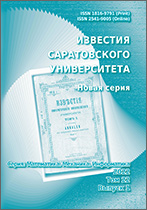|
This article is cited in 2 scientific papers (total in 2 papers)
Scientific Part
Mathematics
A new approach to the formation of systems of linear algebraic equations for solving ordinary differential equations by the collocation method
L. A. Sevastianovab, K. P. Lovetskiya, D. S. Kulyabovab
a Peoples’ Friendship University of Russia (RUDN University), 6 Miklukho-Maklaya St., Moscow 117198, Russia
b Joint Institute for Nuclear Research, 6 Joliot-Curie St., Dubna 141980, Moscow region, Russia
Abstract:
A new algorithm for the numerical solution of one-dimensional Cauchy problems and Poisson equations is implemented. The algorithm is based on the collocation method and representation of the solution as an expansion in Chebyshev polynomials. It is proposed instead of the usual approach, which consists in combining all known conditions — differential (the equation itself) and initial / boundary — into one system of approximate linear algebraic equations, to go to the method of solving the problem in several separate stages. First, spectral coefficients are identified that determine the “general” solution of the original problem. The collocation method determines the interpolation coefficients of the derivative of the solution, and thus the expansion coefficients of the solution itself (except for the initial ones). At this stage, the choice of a good basis with discrete orthogonality makes it possible to use very efficient algorithms for finding the desired coefficients. The complexity of reducing the matrix of a system of linear algebraic equations to a diagonal form becomes equivalent to the complexity of multiplying the Chebyshev matrix of coefficients by the vector of the right side of the system. Then the expansion coefficients of the solution itself (except for the first one or two) are obtained by multiplying the known tridiagonal integration matrix (inverse to the Chebyshev differentiation matrix) by the vector of interpolation coefficients of the derivative. At the last stage, considering the initial/boundary conditions select a “particular” desired solution, unambiguously redefining the missing coefficients of the desired expansion.
Key words:
initial boundary value problems, collocation method, Chebyshev polynomials, Gauss – Lobatto sets, numerical stability, discrete orthogonality.
Received: 14.06.2022
Accepted: 26.09.2022
Citation:
L. A. Sevastianov, K. P. Lovetskiy, D. S. Kulyabov, “A new approach to the formation of systems of linear algebraic equations for solving ordinary differential equations by the collocation method”, Izv. Saratov Univ. Math. Mech. Inform., 23:1 (2023), 36–47
Linking options:
https://www.mathnet.ru/eng/isu966 https://www.mathnet.ru/eng/isu/v23/i1/p36
|

|




 Contact us:
Contact us: Terms of Use
Terms of Use
 Registration to the website
Registration to the website Logotypes
Logotypes








 Citation in format
Citation in format 
